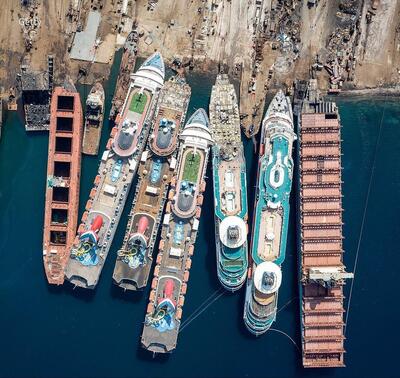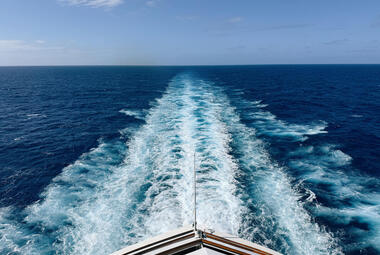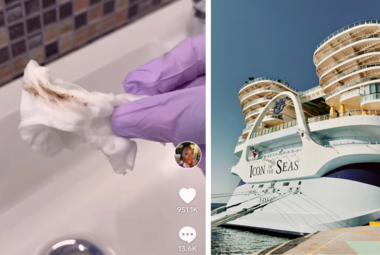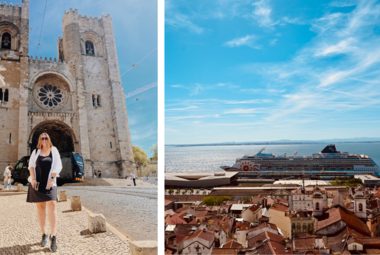Have you wondered what happens to cruise ships after they go into retirement?
It seems like each year there are brand new ships that are bigger and better than the last. Cruise lines are always looking to add the latest and greatest technology, which leaves older ships to be slowly phased into the background and serve specific markets.
Older and smaller ships tend to attract older cruisers, as these don’t have the onboard thrills and amenities that attract families and younger cruisers. Older ships can normally sail to more remote, obscure locations because of their smaller size. Companies are more likely to build large ships these days that pack on 3-4 times as many passengers as previous decades.
Eventually, most cruise ships reach a point of retirement because they are no longer needed by the cruise company. With pressure to keep building new ships that keep up with the evolving market, old cruise ships become unneeded.
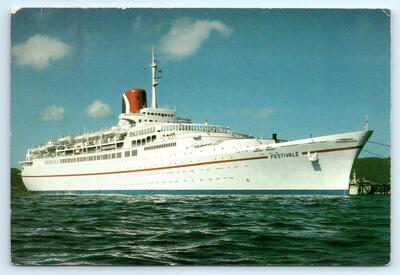
Older ships can also require more maintenance, which becomes costly for cruise line to continue operating. These older ships also lack newer technology and might be less efficient overall than newer ships.
Cruise ships tend to sail for one company between 10-20 years. During this time, a ship is continuously maintained and likely refurbished multiple times. These refurbishments send a cruise ship to a dry dock where it receives upgraded technology and amenities, along with inspecting, painting and general cosmetic improvements.
Most ships will be retired fully after 30-40 years of sailing the sea. Within the last years of a ship’s life, it’s likely to be resold or repurposed before heading to the scrapyard.
Secondhand Tonnage
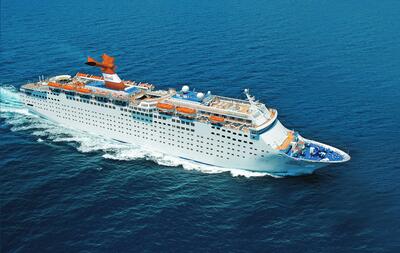
The best case scenario for an old cruise ship is being sold to a smaller corporation and beginning a new life. Ships can also be purchased by other companies, which are rebranded and refurbished to fit the new cruise line. This is commonly known within the industry as ‘secondhand tonnage’.
Before Royal Caribbean’s sale of Empress of the Seas, this ship was originally purchased by the cruise line from Admiral Cruises. Under its old company, the ship sailed under the name Nordic Empress. The ship was sold to investors where it will continue sailing as a cruise ship for an Indian start up cruise liner.

Ships can also be transitioned into other ocean roles; for example, Greek investors are interested in purchasing older cruise ships to be used as island ferries. The
From personal experience, I sailed on Semester at Sea in 2015 on the MV World Odyssey. The ship was used as a ‘floating campus’ for a study abroad program; however, the ship was formerly a German cruise ship named the MS Deutschland before being sold and repurposed.
Covid’s Impact

2020 had an unexpected impact on the future state of cruise ships. The Covid-19 pandemic accelerated the selling and retirement of ships due to the halting of cruises for more than a year. Some ships were sent to retirement perhaps even earlier than originally planned.
Given the financial burden of the pandemic, cruise companies were looking to sell their old ships to generate profits. Moving to a smaller fleet helps the company operate more effectively, as the pandemic reshaped the current cruising landscape for the foreseeable future.
2020 was a big year for the cruise lines to sell their older ships. For example, Royal Caribbean sold two of its oldest ships, the Empress of the Seas and the Majesty of the Seas. This will make room for its newer ships, including the Odyssey of the Seas and Wonder of the Seas.
Carnival also announced the retirement of Carnival Fantasy, Carnival Fascination and Carnival Imagination in 2020. These ships were built between 1990-1995, making them 25-30 years old.
Plenty of other lines took the opportunity to reevaluate their fleet and retire older ships, which helps make room for newer ships to enter the scene.
Scrapped
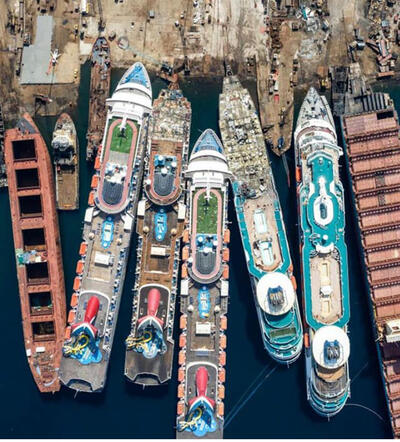
When cruise ships finally retire, they will most likely end up being scrapped in a ship breaking yard. It’s hard to imagine these giant floating cities broken down into scraps, but that’s exactly what happens.
Most shipyards for dismantling cruise ships can be found in Turkey, India and Pakistan. Alang, India is the biggest scrapyard for cruise ships to be demolished. The shoreline stretches for 10 miles and has a 25-foot tidal wave variance, which allows for ships to be brought in during high tide and scrapped during low tide.
Before the ship is demolished, the company is able to retrieve and sell anything they want to salvage from the ship. Anything that isn’t salvaged by the company is then removed from the ship and sold locally. Everything from toilets to chandeliers and chairs can be sold locally before the ship itself is scrapped.
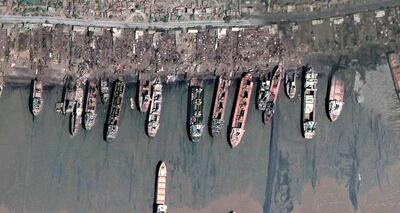
The cruise ships are actually run aground on the beach during the scrapping process. The workers take on the hazardous task of breaking up the ship’s structure and cutting the hull’s steel plate. The ship is meticulously broken down, starting from the ship's bow and working back to its stern.
The ship’s parts and materials are then scrapped and recycled. The steel can be repurposed for use in many different construction projects; as such, the shipyard sells 1.1 million tons of steel in one given year.
The process can take up to 8 months to dismantle the ship piece by piece. In the end, a final piece of floating metal can be seen as the last remnant of a ship.
Tourist Attraction
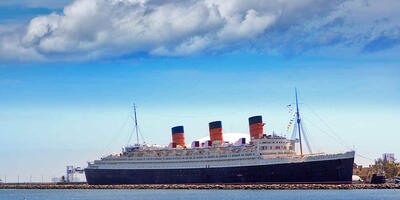
In rare cases, ships can be repurposed into tourist attractions. Although the Titanic had an unfortunate fate, other ships built during this timeframe in history serve as tourist attractions now.
Queen Elizabeth 2 is now used as a floating hotel in Dubai after serving as an ocean liner for Cunard. Similarly, the Queen Mary has a permanent spot in Long Beach, California. The ship has a restaurant and museum to attract tourists while it sits afloat on a permanent dock.
When cruising was shutdown for more than a year, people were fascinated by the concept of seeing massive ‘ghost’ ships floating together in the ocean. Since ships couldn’t sail during the shutdown, most were floating and anchored off shore.
The sight of seeing these massive, empty ships floating in the sea became an attraction off the southern coast of England in the English Channel. One company even started tours that brought tourists up close to the ships!
Abandoned
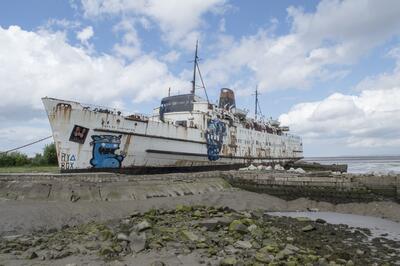
In a sad turn of events, some ships never get the opportunity to have a peaceful retirement. Two famous examples include the American Star and World Discover in which both ships were abandoned at sea.
The American Star accidentally ran aground in the Canary Islands during a rough storm while being towed to a dry dock for refurbishment. The ship was meant to be turned into a 5-star resort hotel off the coast of Phuket, Thailand. The American Star broke in two following the unfortunate incident, which created an unusual sight for locals and tourists alike.
The World Discover is another cruise ship with an unfortunate ending. The German ship struck a reef off the Soloman Islands in 2000 while on an adventure voyage with Society Expedition. After passengers were evacuated, the ship slowly drifted to Roderick Bay and has been resting there ever since. The shipwreck has become a tourist attraction for many.
Sunk
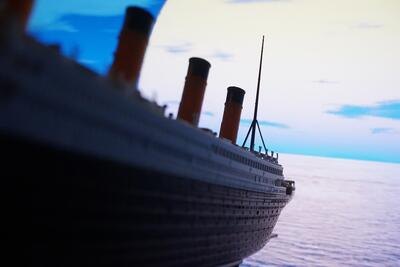
The worst case scenario for a cruise ship’s retirement is the unfortunate sinking of the vessel. The Titanic is the most famous story of a cruise ship sinking, which has captivated historians and cruise fans for years. The event was even turned into a hit movie in 1997 starring Leonardo DiCaprio and Kate Winslet.
More recently, Gap’s Adventure Explorer sank off the coast of the South Shetland Islands after hitting an iceberg in 2007. The ship was sailing on an expedition to Antarctica when a small hole in the vessel eventually caused the ship to sink into freezing waters.
Some ships are also purposely sunk to create artificial reefs for recreational diving. Most often, these include naval ships that are strategically placed in the ocean floor to create artificial reefs for divers to explore.
Other ships haven sunk and accidentally created some great diving conditions, such as the sinking of the ship Bianca C off the coast of Granada. The shipwreck is now one of the world’s best diving locations in the world, as it has been inhabited by sharks, eels and plenty of other marine life.


